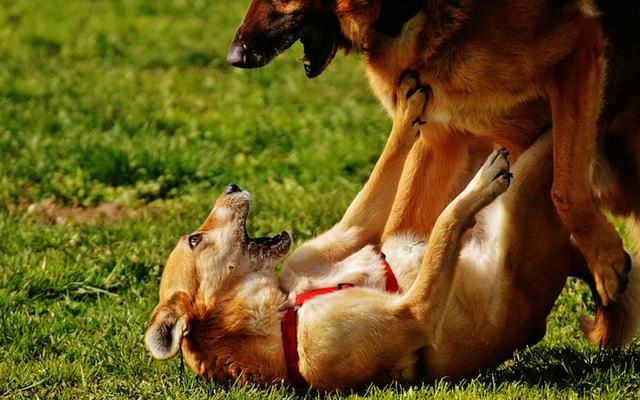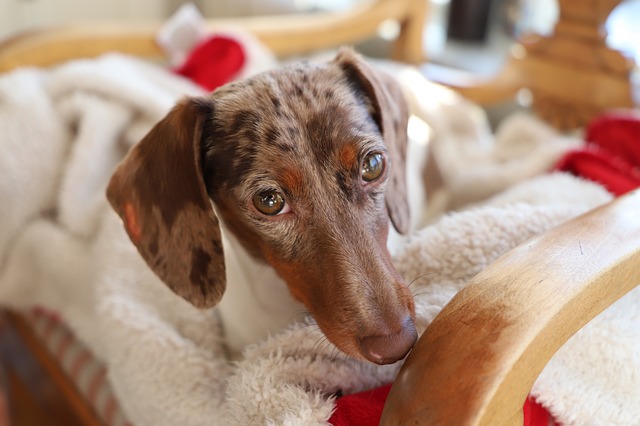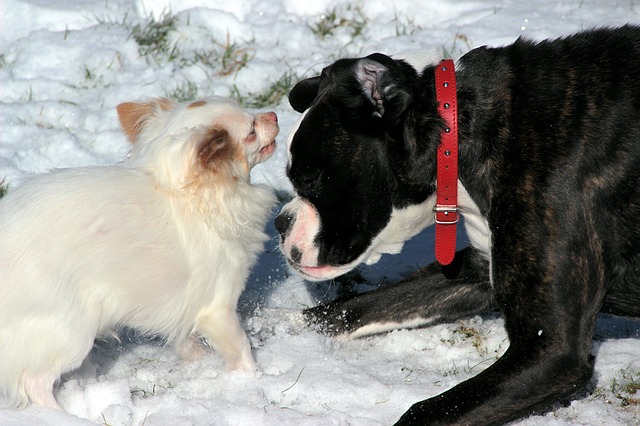It’ll take more than a belly rub and a biscuit for a sensitive pup to forget the day their trust in other dogs was shattered. A single painful experience, like a dog fight, can cause a formerly carefree dog to cower or lash out every time they’re near another canine. It’s a natural response to fear, but it doesn’t have to be permanent.
There is no fool-proof method in helping a dog recover from a stressful experience, but with time, compassion, and the right training techniques, it’s always worth the effort. Whether you want to add another pet to the family or simply want to go on walks without worrying about crossing paths with other dogs, try these tips to help your pup feel more comfortable around their own kind.

1. Keep Things Normal
After you bring your pup home from being checked out by the vet, your first instinct will be to shower them with all your love and attention. They’ll appreciate the comfort, but it’s important to not coddle them. Give yourself one day after the incident to dote on your dog, but then it should be business as usual.
Your dog already feels like their life has been turned upside down. They’ll rely on the predictability of being home now more than ever. They might act out in response to stress, but don’t treat them any differently than you would have before they were attacked. If they usually get a time out for jumping on the counter, don’t go easy on them because you feel bad for them. Let them know that, yes, the attack happened, but it doesn’t change how they live their life.

2. Work on Slow Re-Socialization
While you want your dog to feel like everything is normal, sometimes their emotions will get the best of them. Don’t ignore the signs that your dog’s experience has changed the way they feel about other dogs. If they cower, act aggressively, or show other sings of being generally stressed out around other dogs, their confidence has been shaken. Sometimes their feelings of unease will get better with time, but don’t hesitate to start re-socialization.
Re-socialization is reinforcing the idea that other dogs are good. Your pup used to know this, but now they need a reminder. The key here is to move slowly. Don’t drop them off at the dog park and expect everything to be like it was before. Instead, start by situating your pup somewhere they can see other dogs but not interact. If they seem comfortable, give plenty of praise and treats. Gradually move closer and gauge your dog’s comfort level. If they start showing signs of stress or fear, work on capturing their attention with positive reinforcement. Don’t move closer until they’re 100% ready. This method of training is called desensitization conditioning.

3. Visit Old Friends
In most cases where a dog is attacked, it’s with a dog they just met or never got along with in the first place. Dogs are like people, and sometimes they like everyone and sometimes there are players at the park they simply don’t mesh with. But if your dog has a particular friend they knew before they were attacked, you can use that positive foundation to remind your pup about the good times.
Try scheduling a play date in a private area for your dog and their friend. Choose an area that’s neutral to both dogs, so the issue of being territorial won’t come into play. Take it slowly, and first let the dogs sniff each other. If that goes well, dole out plenty of praise. Skip the treats here to avoid possible food aggression. Once both tails are wagging and neither dog is showing signs of stress, let them loose. Active play is one of the best remedies for a stressed out dog.
4. Focus on Individual Needs
Playing well with an old friend is a good start, but it doesn’t always solve the problem. Some dogs are comfortable around dogs they knew “before,” but new dogs still pose a threat. If that’s the case, continue working on desensitization conditioning.
The most important thing to remember is to not give up. Helping a dog rebuild their trust in other canines will take time. Your dog is an individual with specific needs and sensitives.
Every time your dog has a positive interaction, make sure they know how great they are. They’re relearning something they used to know, and your support and reassurance will go a long way. Celebrate the small victories, but remember not every encounter will be good. When bad things happen, resist the urge to punish their behavior. Punishment will only add more stress to an already stressful situation. When things go sour, simply get your dog away from the situation and try again later.

5. Introduce Dogs the Right Way
If you want to bring another dog into your home or simply help your dog make a particular new friend, there’s a right way and wrong way to go about it. First impressions matter, and they’re especially important when your dog is already nervous due to past experiences. To start, choose a meeting place that is completely neutral, secure, and with few distractions. Keep both dogs on leashes, but give them a little freedom to move on their own. Feeling completely restrained usually makes dogs feel anxious.
When guiding the dogs to approach each other, do it from the side; a dog approaching head-on can be viewed as a threat. Help your pup stay calm by keeping your own emotions in check. Move slowly, and look for signs your dog is uncomfortable. A “frozen” posture, cowering, or lunging means your dog isn’t ready for this step. If things go well with the initial sniffs, start walking together as a group. This will give the dogs a chance to do their own thing while being aware of their company. If the dogs are going to be spending more time together, supervise all interactions for the first several weeks.
There’s no magic word or step-by-step instruction manual that will erase your dog’s fear of being attacked. Their behavior is their way of telling you how they feel, and it’s your job to listen. Take your cues from them, and never force them into a situation they’re not ready for. It requires patience and understanding, but the most important thing to remember is to not give up. The longer you wait to re-socialize, the harder it will be for them to recover.
